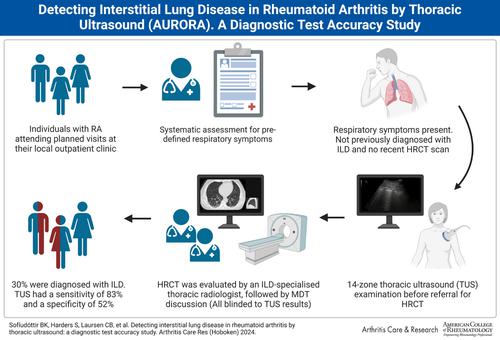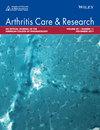Detection of Interstitial Lung Disease in Rheumatoid Arthritis by Thoracic Ultrasound: A Diagnostic Test Accuracy Study
Abstract
Objective
To determine the diagnostic accuracy of thoracic ultrasound (TUS) for detecting interstitial lung disease (ILD) in rheumatoid arthritis (RA) with respiratory symptoms.
Methods
Individuals with RA visiting rheumatologic outpatient clinics in the Region of Southern Denmark were systematically screened for dyspnea, cough, recurrent pneumonia, prior severe pneumonia, or a chest x-ray indicating interstitial abnormalities. Eighty participants with a positive screening were consecutively included. Individuals were not eligible if they had a chest high-resolution computed tomography (HRCT) less than 12 months ago or were already diagnosed with ILD. A blinded TUS expert evaluated TUS, and TUS was registered as positive for ILD if at least 10 B-lines or bilateral thickened and fragmented pleura were present. The primary outcomes were TUS's sensitivity, specificity, and positive predictive value and negative predictive value. An ILD-specialized thoracic radiologist assessed HRCT, followed by a multidisciplinary team discussion, which was the reference standard. The accepted window of HRCT was less than 30 days after TUS was performed.
Results
A total of 77 participants received HRCT less than 30 days after TUS, and 23 (30%) were diagnosed with ILD. TUS had a sensitivity of 82.6% (95% confidence interval [CI] 61.2%–95.0%) and a specificity of 51.9% (95% CI 37.8%–65.7%), corresponding to a positive predictive value of 42.2% (95% CI 27.7%–57.8%) and a negative predictive value of 87.5% (95% CI 71.0%–96.5%).
Conclusion
To our knowledge, this prospective study is the first to use respiratory symptoms in RA as inclusion criteria. Systematic screening for respiratory symptoms combined with TUS can reduce the diagnostic delay of ILD in RA.



 求助内容:
求助内容: 应助结果提醒方式:
应助结果提醒方式:


